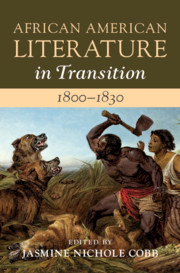Book contents
- African American Literature in Transition, 1800–1830
- African American Literature in Transition
- African American Literature in Transition, 1800–1830
- Copyright page
- Contents
- Figures
- Contributors
- Preface
- Chronology
- Introduction
- Part I Black Organizational Life before 1830
- Part II Movement and Mobility in African American Literature
- Chapter 4 Early African American Literature and the British Empire, 1808–1835
- Chapter 5 Robert Roberts’s The House Servant’s Directory and the Performance of Stability in African American Print, 1800–1830
- Chapter 6 Dream Visions in Early Black Autobiography; Or, Why Frederick Douglass Doesn’t Dream
- Part III Print Culture in Circulation
- Part IV Illustration and the Narrative Form
- Index
Chapter 5 - Robert Roberts’s The House Servant’s Directory and the Performance of Stability in African American Print, 1800–1830
from Part II - Movement and Mobility in African American Literature
Published online by Cambridge University Press: 11 March 2021
- African American Literature in Transition, 1800–1830
- African American Literature in Transition
- African American Literature in Transition, 1800–1830
- Copyright page
- Contents
- Figures
- Contributors
- Preface
- Chronology
- Introduction
- Part I Black Organizational Life before 1830
- Part II Movement and Mobility in African American Literature
- Chapter 4 Early African American Literature and the British Empire, 1808–1835
- Chapter 5 Robert Roberts’s The House Servant’s Directory and the Performance of Stability in African American Print, 1800–1830
- Chapter 6 Dream Visions in Early Black Autobiography; Or, Why Frederick Douglass Doesn’t Dream
- Part III Print Culture in Circulation
- Part IV Illustration and the Narrative Form
- Index
Summary
This chapter explores issues of black mobility by considering the circulation of Robert Roberts’s 1827 book, The House Servant’s Directory: or, A Monitor for Private Families. The House Servant’s Directory holds an important place in book history as one of the earliest known commercially produced books written by a formerly enslaved African American man. Initially, the book received printings in both New York and Boston and was popular enough to warrant two subsequent editions. However, the popular circulation of The House Servant’s Directory exceeded the “circulation” of its indentured author, as his mobility was limited by restrictions on people of African descent. And while the story of David Walker’s broad circulation of his 1829 Appeal fits well into narratives about Black mobility and fugitivity, the early African American print sphere is more often marked by less successful efforts at circulation.
Keywords
- Type
- Chapter
- Information
- African American Literature in Transition, 1800–1830 , pp. 119 - 145Publisher: Cambridge University PressPrint publication year: 2021

